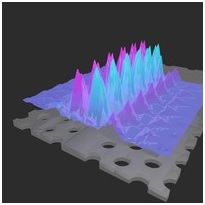April 21, 2015
Researchers from FOM institute AMOLF have used the classical toolbox of physics to make predictions about the quantum world. Using a classical experiment, they showed how the direction in which a quantum light source emits light reveals the quantum state (spin) of that source. On 2 April the AMOLF researchers published the results in Nature Communications.
Classical experiment in the hall of mirrors
The physicists injected spinning light into a mini ‘hall of mirrors’, a photonic crystal, from which the light could only escape in two directions. The researchers discovered that they could influence which exit the light escapes from. This was achieved by very precisely choosing the location at which they injected the light.
In the hall of mirrors there are locations where light naturally starts to spin: the electrical field of the light rotates there. Light that travels in a single direction through the hall of mirrors would, for example, always rotate left at such a vortex location. At such a vortex location in the empty, lightless hall of mirrors, the researchers introduced some spinning light. If the spin direction of this light from the needle matched the natural spin direction at the vortex location, light left the hall of mirrors on the one side. If the spin direction of the light from the needle was the opposite of the standard vortex direction, the light went the other way.
Quantum world
This trick, which falls within the boundaries of classical physics, reveals how light will behave in the quantum world. That is because quantum light sources often emit light that spins (is circularly polarised), just like the light the researchers introduced to the hall of mirrors. The spin direction of the spinning light from quantum sources is directly dependent on the quantum state (spin) of the source. Therefore, if the experiment were repeated with a quantum source, the quantum state would determine the spinning direction of the light and with that the direction of escape. In other words, the direction in which the emitted light escapes reveals the state of the light source: the direction of the light emitted has therefore become a source of quantum information.
Hall of mirrors
The aforementioned hall of mirrors that the researchers used for their experiment is in fact a photonic crystal that consists of an ultra-thin wafer of silicon that is just 220 nanometres thick (a nanometre is one millionth of a millimetre). In the silicon a pattern of holes has been etched, which ensures that just like in a real hall of mirrors, light is reflected in all directions and cannot simply escape. The properties of the photonic crystal determine where the vortex locations are and in which direction light at these locations normally rotates.
Reference
B. le Feber, N. Rotenberg & L. Kuipers
Nanophotonic control of circular dipole emission
Nature Communications 6, 6695 (2015) | DOI: 10.1038/ncomms7695













